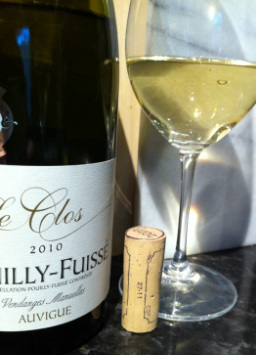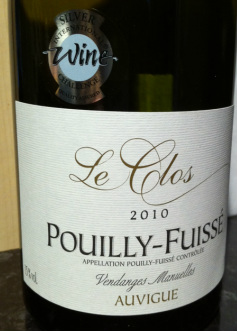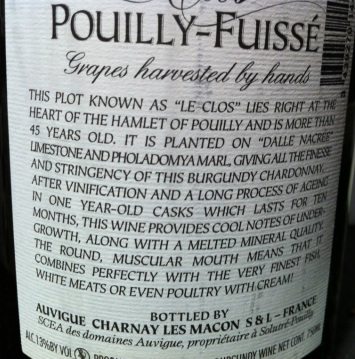 Le Clos Pouilly Fuisse 13% abv £19.99 Waitrose
Le Clos Pouilly Fuisse 13% abv £19.99 Waitrose Still, there are some bargains out there (stay tuned for an upcoming post on some special winners under £10). And there are one or two bottles that are worth a splurge if you're looking for a gift, or a wine for a truly special occasion. This one falls more into the splurge category at £19.99 from Waitrose Cellar. I was lucky enough to pick it up at £14.99 during the recent 25% discount offer, and seriously wish I'd bought more than one bottle.
Le Clos Pouilly-Fuissé 2010 Auvigue doesn't exactly trip off the tongue.
It's an International Wine Challenge Silver medal winner but with it's golden hues and voluptuous mouthfeel, it's a touch of gold.
 International Wine Challenge Silver Medal
International Wine Challenge Silver Medal For the avoidance of doubt, it's worth noting that Pouilly-Fuissé (pronounced something like "pweeyee-fweesay") is not the same wine, or even close to Pouilly-Fumé. The latter is again, a premium white wine, but made from 100% Sauvignon Blanc in the Loire Valley around 200km north west of Poully- Fuissé. Who said French wine was complicated?
 Well, some of the label is in English. Pholadomya marl, anyone?
Well, some of the label is in English. Pholadomya marl, anyone? Although much of it is in wine speak, it's still a useful aid to the customer. We're told that the grapes are hand-harvested which helps explain the premium price, but also the quality of the wine.
Many of our ideas about wine harvesting are probably of the jolly farmer and a few students casually picking the bunches of grapes one sunny day in September. You may even have done this yourself, and if you have, you'll know it's back-breaking work. Nowadays, and especially for the cheaper branded wines you'll buy in the supermarket, much harvesting is done by machine.
This keeps costs down, but also creates challenges for the winemaker. For example, there's little chance to select only the best bunches, it can be difficult to harvest whole bunches, and there's a lot of "material other than grapes" to sort through, ranging from leaves to wildlife, not to mention inclusion of grapes that are rotten or under-ripened.
So, although it adds cost, hand-harvesting is preferred by many premium wine-makers, allowing them to pass several times through the vineyard and only pick the full bunches that are ready, or, in some cases, even individual grapes.
Our wine label info gives us a good background on how the wine has been made and aged. Many white wines are designed to be drunk young and fresh, in the year after the harvest. Age isn't always a good thing when it comes to wine. Here, we have a 2010 and it's spent 10 months in oak. Rather than blockbuster new oak (remember a French oak barrel can cost around €800), the winemaker has elected to use barrels that have been previously used. This may seem like a shrewd cost-cutting measure, though the real reason is to ensure that the wine still tastes of fruit rather than trees. Delicate white wines can be overpowered by new oak, tasting so much of toasty, nutty, vanilla that there's very little fruit left. Aging in second-use oak allows more subtle oaky notes to permeate the wine, so we find more creamy, dairy, buttery notes rather than a full-on wood-fest.
And what does it taste like? I'm not sure about you, but "cool notes of undergrowth, melted mineral and a muscular mouth" aren't the first words that spring to mind when I think about what I'm looking for in a white wine. So let me try to translate that for you.
This Chardonnay is buttery, creamy, with a subtle toastiness; imagine toasted brioche, dripping with unsalted butter. There is lots of fruit and combined with a refreshingly mouthwatering acidity, the sensation is much like biting into a perfectly ripe, juicy pineapple, almost with the same tingle on the roof of the mouth. It's full-bodied and voluptuous, meaning it fills your mouth with an almost velvety texture, and there's a lasting flavour, almost a hint of steel. Put your nose in the glass and it can only be top-quality sensitively-oaked Chardonnay. There are real complex notes here - more things to find and each sip is a pleasure. This is subtle but not austere, ripe but not overblown, a balanced wine that surely must convince the abc* brigade of the error of their ways.
I asked Mr Purple Teeth for his description, as I usually do. This time he declined to comment, simply because he was too engrossed in the glass. By his second glass, he was even less interested in finding the words to describe it, as he simply wallowed in it's (silver) golden glow.
Cheers!


 RSS Feed
RSS Feed
